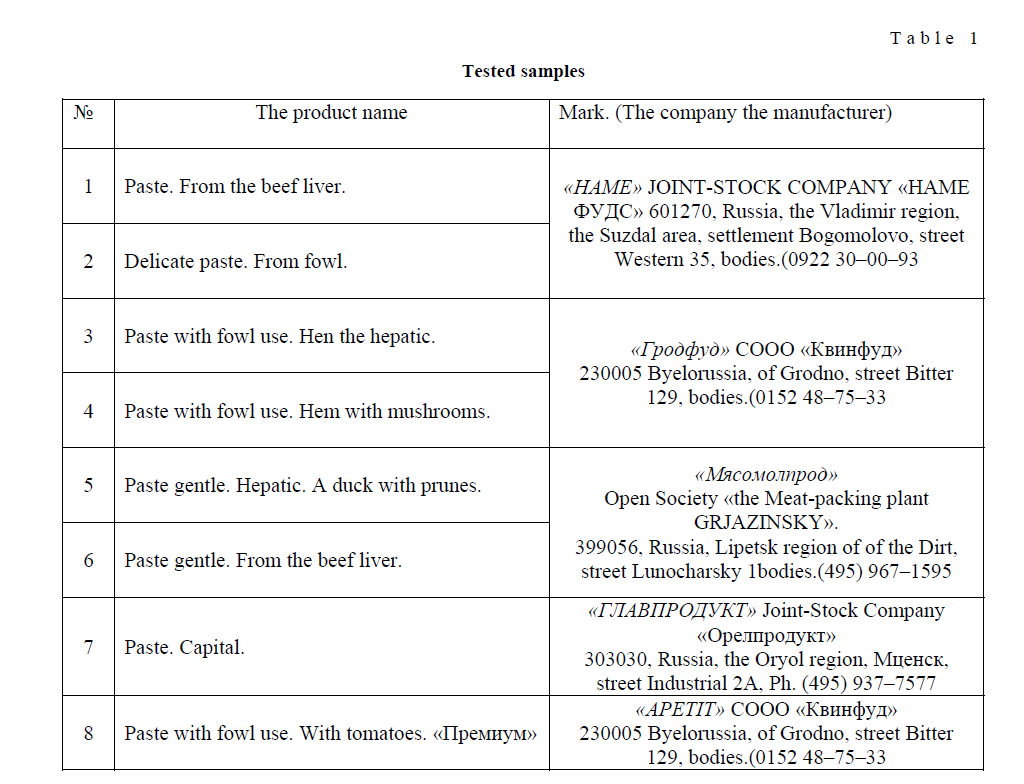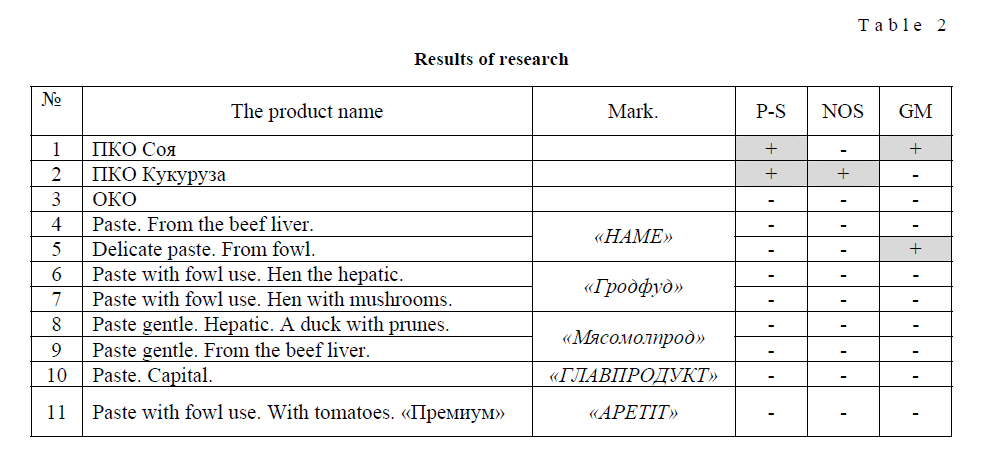All over the world the market of a foodstuff is flooded by the goods containing genetically modified organisms. In agricultures of many leading countries-exporters of a vegetative foodstuff and vegetative raw materials, plants with the changed genetic code for a long time already are grows up. Production of new transgene plants as yet one of perspective and most developing directions of biotechnology in agro production sphere [1, 2].
Transgene names those kinds of plants, in which gene (or genes) transferred from other kinds of plants or animals [3] is successfully functions.
Areas under GM-plant crops anniversarily increase approximately on 60 %. Apparent, now it exceeds 50 million hectares that makes about 3 %-5 % from the all areas of crops. In production of foodstuff 70 % GM-soya, 25 % GM-corn, and also a potato, rice, rape, tomatoes, a sugar beet are used. The general manufacturer of production which contains GMO — is USA that makes 68 % GM-products, 12 % Argentina, 6 % Canada, 5 % Brazil, 4 % China [4, 5, 6].
Now there is no the valid scientific information authenticates to any inherent danger of genetically modified organisms (GMO). However it does not prove full absence of the risks associated with ubiquitous introduction of GMO. Opponents of accelerated introduction GM-organisms declare that outcomes from the eating of such products have long-term character and shows through a few generations. As proofs experiences on animals, with amazing results are represented. Accounting a large quantity of population which consuming GM-soya, corn, rice, a potato, and other plants, the slowed down effects can lead to mass unwanted consequences [7, 8, 9].
The most part of genetically modified products is using for export. Now more and more countries accepts laws on required marking of such goods and even prohibition of it import to certain territories [10].
In Kazakhstan the question of GMO disturbs only certain organizations. The researches spent in this area are insignificantly and limits by detecting GMO in a foodstuff and nothing more. At least and this tests brings results. For example, established, that 60–75 % of all imported foodstuff in the country contains GMcomponents [11]. Absence of the necessary equipment in the country impedes to other kinds of research.
Expounded above confirms the necessity of researching foodstuff on presence GMO in it.
For today, the most effective method of monitoring for presence GMO in a foodstuff is method of PCR allowing not only to detect presence GMO in it, but also to define their quantity [12–19].
Goal of this research is testing of meat pastes, by method Polymerase Chain Reaction (PCR), on presence in its GMI.
As criteria of selection of products served: availability of the prices; prevalence in the markets of a foodstuff; absence of marks on GMI ingredients.
Results of the present research can be used for informing authorities of Gossanepidnadzor, and also the population on presence GMI in meat products, specifically meat pastes.
Materials and methods
Materials. As investigated products, have chosen the group of meat pastes widely presented in local retail trade. Names of products and the list of brands (the companies of producer) are presented in Table 1.
Tested samples
T a b l e 1

Methods. As a method of molecular-genetic analysis on detection GMI, applied Polymerase Chain Reaction (PCR), allowing to detect insignificantly small fragments of DNA by multiple amplification.
Extraction of DNA from the described products realized with application of the kit «DNA-SORB-C» a variant 50. At the present procedure used a universal sorbent for sedimentation of DNA molecules.
Amplification of sequence with promoter 35S, and also soya and corn genes made with kit «AmpliSens variant 50-R the PLANT-SREEN», sequences of terminator Nos realized with application kit «AmpliSens variant 50-R Terminator Nos», sequences of DNA of the genetically-modified soya of a line 40–3-2 with the use of kit with reactants «AmpliSens a variant 50-R GM-soya 40–3-2».
Electrophoretic analysis of products PCR in agar gel made by kit «EF variant 300». All sets of reactants made by «ФГУН ЦНИИЭ Роспотребнадзора».
The results analysis of electrophoresis realized by processing of collected data using computer system Totallab.
Results of research
For screening on presence GMI initial experiments made with application of test system «PLANTSREEN». After extraction of DNA from all tested samples, set up amplification reactions in a assorted mode. The number of cycles made 42. Post-up termination of PCR, amplification products analyzed by procedure of electrophoresis in agar gel. Applied positive and negative sample controls (PCS and the NCS accordingly). In the given test system applied 2 variants PCS for detecting genetically modified soya (PCS 1) and corn (PCS 2). For reliability of the collected results experiment has repeated three times with each sample. The photo of electrophoresis presented in Picture 1.

Pic. 1. Electrophoretogram of DNA, amplification with application of test system «PLANT-SREENS»
1. PCS 1 soya 400 and 194 pn.
- PCS 2 corn 544
- From the beef liver. «HAME»
- From fowl. «HAME»
- Paste with fowl use. Hen the hepatic. «Гродфуд»
- Paste with fowl use. Hen with mushrooms. «Гродфуд»
- Paste gentle. Hepatic. A duck with prunes. «Мясомолпрод»
- Paste gentle. From the beef liver. «Мясомолпрод»
- Capital. «ГЛАВПРОДУКТ»
- Paste with fowl use. With tomatoes. «Премиум» «APETIT»
By results of research with the use of given test system, neither of tested samples DNA fragments, the size 400 and 544 pn., that corresponds to length amplification DNA fragments genome of soya and corn, have not been detected. DNA fragments the size 194 pn. also are not detected, corresponding to the promoter 35 S, most often used at producing of transgene plants. Absence of any fluorescing strips of DNA in a path 3, corresponding the NCS, proves reliability of the collected results. Therefore, any of the tested products did not contains GMO lines of the soya and corn, which presence is founds out by application of the given test system.
Following recommendations «Instruction AmpliSens–50-R», at reception of negative result in test system «PLANT-SREEN», it is necessary to check up testing products with the kit of reagents «Terminator NOS» and «GM Soya 40–3-2». All objects tested in the described systems.
Procedure of extraction DNA material from testing samples made without changes. With extracted DNA samples set up PCR with test system «Terminator NOS» in a corresponding mode with quantity cycles of amplification 42. By completing of reactions made detection products in electrophoretic gel. Results are presented in Picture 2.
As yet electrophoresis the path 3 is not used. Such numbering used for retention of sequence of objects resulted in Table 1. During the analysis of the received results required fragments of DNA corresponding PCS given test system have not been detected (180 items pn.).

Pic. 2. Electrophoretogram of DNA, amplification with application of test systems «Terminator NOS»
1. PCS 180 pn.
- NCS
- ————————-
- From the beef liver. «HAME»
- Delicate paste. From fowl. «HAME»
- Paste with fowl use. Hen the hepatic. «Гродфуд»
- Paste with fowl use. Hen with mushrooms. «Гродфуд»
- Paste gentle. Hepatic. A duck with prunes. «Мясомолпрод»
- Paste gentle. From the beef liver. «Мясомолпрод»
- Capital. «ГЛАВПРОДУКТ»
- Paste with fowl use. With tomatoes. «Премиум» «APETIT»
After screening researches it is recommended to use another test systems, allowing to define concrete lines of genetically modified organisms used in producing of the given product. The next experiments made with application of test system «GM Soya 40–3-2» for the purpose of detecting fragments of genetically modified soya of a line «40–3-2».
Procedure of extracting DNA, statement reaction of amplification, electrophoresis, and also its detection and the analysis by using computer system also made without changes. The picture of electrophoresis amplification DNA fragments is presented in Picture 3.

Pic. 3. Electrophoretogram of DNA, amplification with application of test systems «GM Soya 40–3-2»
1. PCS 274 pn.
- NCS
- ————————-
- From the beef liver. «HAME»
- Delicate paste. From fowl. «HAME»
- Paste with fowl use. Hen the hepatic. «Гродфуд»
- Paste with fowl use. Hen with mushrooms. «Гродфуд»
- Paste gentle. Hepatic. A duck with prunes. «Мясомолпрод»
- Paste gentle. From the beef liver. «Мясомолпрод»
- Capital. «ГЛАВПРОДУКТ»
- Paste with fowl use. With tomatoes. «Премиум» «APETIT»
In this experiment the positive result corresponding to the sizes of amplification fragments DNA is 274 pn., has shown one of tested samples, «Delicate paste. From fowl» Joint-Stock Company producer «BOOR ФУДС». In other tested products in the given test system required GMI have not been found.
Thus, the researches authenticating to presence GMI in one tested sample of meat pastes and about absence of required fragments of DNA in other samples. Summary data about results of researches are presented in Table 2.
Results of research
T a b l e 2

Now researches of meat pastes about contents in its of genetically modified components proceed. The future researches suppose expansion of a spectrum of testing objects, and also testing of other meat products for the purpose of detection in its structure transgene plants (soya, corn, etc.).
On the basis of the collected results it is possible to draw following conclusions:
- With application screening test systems «PLANT-SREENS» in one of tested samples GMI is not de-
- With test system «Terminator NOS» required fragments of DNA, in tested samples, are not
- Components of transgene soya detected in analysis with test system «GM Soya 40–3-2» in DNA extracted from «Delicate From fowl» «HAME» sample. In other tested samples required components are not detected.
The literature list
- Пирузян Э.С. Основы генетической инженерии растений. — М.: Наука, 1988. — 304 с.
- ГМО — зона повышенного риска / Под ред. Е.Климова. — Алматы: Спектр, 2003. — 52 с.
- Андреева А.П. Биотехнология. — Караганда: Изд-во КарГУ, 2004. — 191 с.
- http://www.biotechnolog.ru
- http://www.greenpeace.org
- http://www.antigreen.org
- Глеба Ю.Ю. Биотехнология растений // Соросовский образовательный журн. — 1998. — № 6. — С. 3–8.
- Лихтенштейн К., Дрейпер Дж. Генетическая инженерия растений // Клонирование ДНК. Методы / Под ред. Д.Гловера. — М.: Мир, 1988. — С. 315–380.
- Лаутова А.А. Генетическая инженерия растений: свершения и надежды // Соросовский образовательный журн. —— № 10. — С. 10–17.
- Глик Б., Пастернак Дж. Молекулярная биотехнология. Принципы и применение. — М.: Мир, 2002. — 589 с.
- Дейнеко Е.В., Загорская А.А., Шумный В.К. Т-ДНК — индуцированные мутации у трансгенных растений // Генетика. — 2007. — Т. 43. — № 1. — С. 5–18.
- ГМО: контроль над обществом или общественный контроль. — М.: Эремурус,
- Щелкунов С.Н. Генетическая инженерия. — Новосибирск: Сиб. универ. изд-во, 2004. — 496 с.
- Картахенский протокол по биобезопасности к Конвенции о биологическом разнообразии. — 2000. — 29 февр.
- G.Carrau, R.C.Lopez The GMO regulation in the EU and the commercial conflict with the United States report on 10 congress EAAE, Exploring Diversity in the European Agri-Food System, Zaragoza, Spain, 28–31 August 2002.
- http://www.biogene.ru
- http://www.biosafety.ru
- http://gmobelarus.by
- http://www.nkj.ru